October 2011
It is almost noon when I arrive at Agra Fort tired, dehydrated, sunburned and with the beginnings of a headache.
It has been a long day that began before sunrise by queuing up with what seemed like the rest of world to see the Taj Mahal. Then it was onwards to Sikandra through terrible traffic and road rage incidents to see Akbar’s Mausoleum, and finally back to Agra to visit the I’timad-ud-Daulah.
It is hot and dry and the Fort is quite crowded. I’m exhausted and unable to concentrate on what the guide is saying. After about 15 minutes like this, I give up and decide to leave, with the hope that I’ll get a chance to visit Agra again and walk through the Fort gates once more.
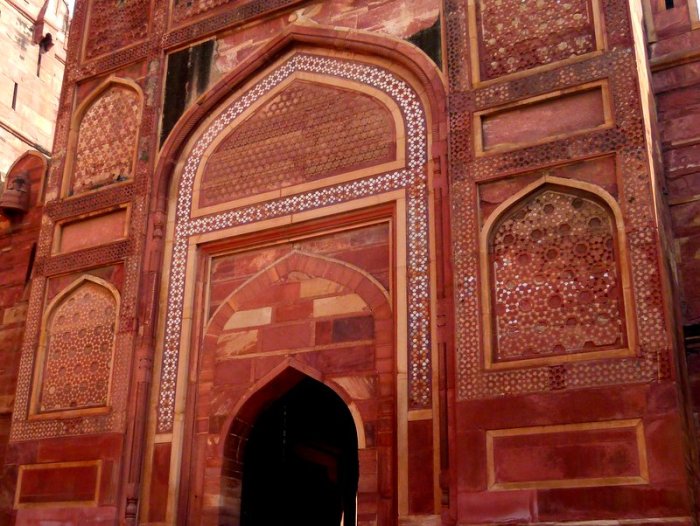
That chance comes almost 3 years later. 🙂
September 2014
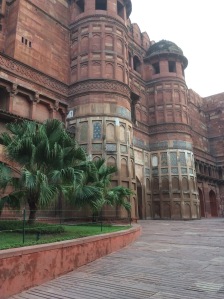 It is 6.30 am and the sun has just risen when I arrive at the Agra Fort fresh from a good night’s sleep and raring to explore it. I buy my tickets, hire a guide, walk past a smiling security guard and I’m in.
It is 6.30 am and the sun has just risen when I arrive at the Agra Fort fresh from a good night’s sleep and raring to explore it. I buy my tickets, hire a guide, walk past a smiling security guard and I’m in.
The morning is cool, though there are indications that the day will be a hot one. The morning haze initially makes everything look dull and grey, but as the sun ascends, the sunlight permeates through it suffusing the red of the Fort with a beautiful golden glow.
I’m the first tourist to enter the Fort that morning and as I find out later, the only tourist for the next 2 hours or so — everyone’s busy at the Taj, you see. Not that I’m complaining. 🙂
 The Agra Fort is a massive fortified structure built by the Mughal Emperor Akbar on the site of a pre-existing Lodi-era Fort. Some accounts say that there has always been some sort of fortification right from Ashokan times; the Lodi-era Fort itself was supposed to have been constructed on an existing fort called Badalgarh, built by a local Rajput chief by the name of Badal Singh.
The Agra Fort is a massive fortified structure built by the Mughal Emperor Akbar on the site of a pre-existing Lodi-era Fort. Some accounts say that there has always been some sort of fortification right from Ashokan times; the Lodi-era Fort itself was supposed to have been constructed on an existing fort called Badalgarh, built by a local Rajput chief by the name of Badal Singh.

The Fort is built from the same kind of red sandstone used at Fatehpur Sikri and makes for an impressive sight.
The Fort is semi-circular in shape, and surrounded by two moats. The outer one was a wet moat that used to have crocodiles and the inner one a dry moat that used to hold lions and tigers.
The towering fort walls are near perpendicular enclosing a circumference of 2.5 km. When the Fort was built, the River Yamuna flowed next to it; today, a road runs along the Fort, the river having receded to some distance away.

Agra Fort, also known as the “Lal–Qila” (Red Fort), “Fort Rouge” or “Qila-i-Akbari”, was the headquarters of the Mughal Empire. Or rather it was the headquarters of the Mughal Empire whenever Agra happened to be the capital. After the Mughals, the Marathas and then the British occupied the Fort.
Agra Fort took 95 years to be completed in the way that we see it today. Even though four Mughal Emperors lived here — Akbar, Jahangir, Shah Jahan and Aurangzeb — only the first three contributed to the building activities in the Fort. It is interesting to see the progression from sandstone (Akbar) to a mix of sandstone and marble (Jahangir) to only marble (Shah Jahan) as the preferred choice of building material. At one point, the Fort was supposed to contain within its walls 500 buildings; most of the non-imperial buildings were destroyed during British occupation.
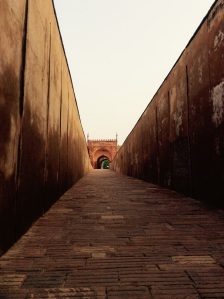 A large portion of the Fort is not accessible to the public today as it is occupied by the Indian Army. That’s one of the reasons why visitors do not enter the Fort from what was originally the main gate. Rather, they enter the Fort, as I did, from the Amar Singh Gate, which was supposed to be the private entrance of the royal family.
A large portion of the Fort is not accessible to the public today as it is occupied by the Indian Army. That’s one of the reasons why visitors do not enter the Fort from what was originally the main gate. Rather, they enter the Fort, as I did, from the Amar Singh Gate, which was supposed to be the private entrance of the royal family.
Once inside and a couple of twists and turns later, there is a steepish climb up a grooved ramp. The grooves enabled quick movement of horses then; mere mortals like me today huff and puff discreetly to the top to see the first of the many courtyards and buildings open to the public and begin the tour of Agra Fort.
The next set of photographs is a glimpse into the marvel and grandeur of the Agra Fort that I saw on that beautiful morning
I thought these were tiles, and the guidebooks also mention that they are tiles. But my guide and a closer look revealed otherwise; these are painted on the Fort walls to look like tiles.

Contrary to its name, Jahangir Mahal was actually built by Akbar. Two courtyards, lots of rooms, exquisite sandstone carvings… it’s an architectural delight.

Artisans from Bengal were brought to create these carvings on sandstone. I cannot help wondering how long it took to carve these…

Khas Mahal was built in the 17th century. Constructed almost entirely out of white marble the exteriors and the interiors are inlaid with different coloured stones as well as semi-precious gemstones to create geometric or floral patterns.
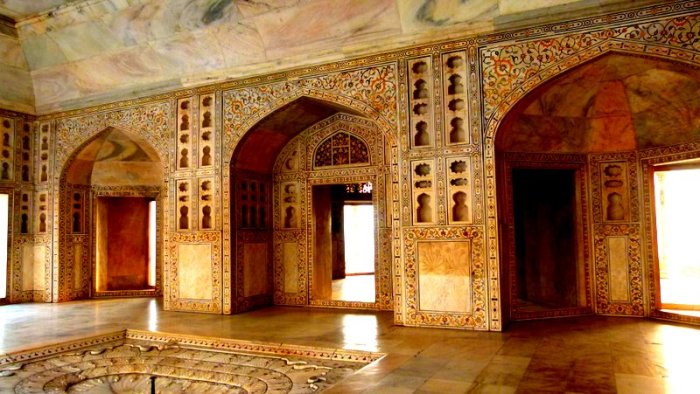
Just off the Khas Mahal is what used to be the living quarters of Shah Jahan. On either side of these are palanquin-shaped structures that were the living quarters of Shah Jahan’s daughters — Roshanara and Jahanara. The arched roof was once plated with gold.

Khas Mahal overlooks Anguri Bagh, a traditional Mughal style garden divided into four quarters. The rooms leading off from this courtyard are considered to have been for the zenana or the women of the royal family.
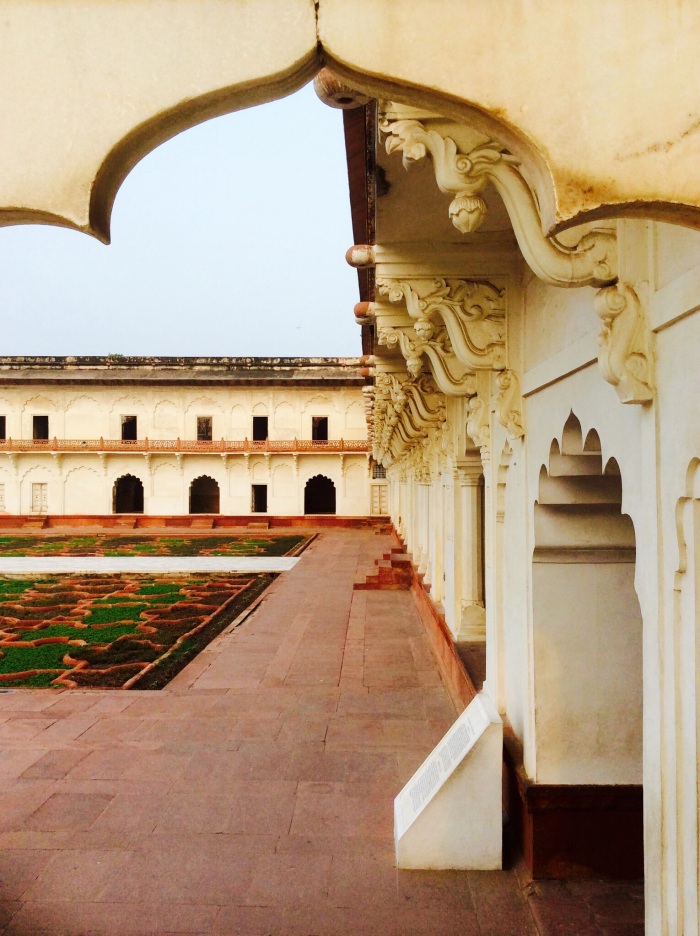
The Musamman Burj or Shah Burj is undoubtedly the best known structure within the Agra Fort. It is also the most beautiful. An octagonal shaped tower, Shah Jahan spent the final years of his life captive in this very tower. He spent his waking hours staring across the Yamuna at the Taj Mahal, where his beloved wife Mumtaz lay buried. he was allowed to leave the Burj only to pray at his personal mosque a little distance away.


Macchli Bhavan is another courtyard complex that is so named as it used to have a fish pond. The imperial baths were in this part of the Fort.

Machhli Bhawan leads to the Diwan-e-Aam or the hall of public audience. It is a large many pillared hall that looks out into an even larger courtyard.
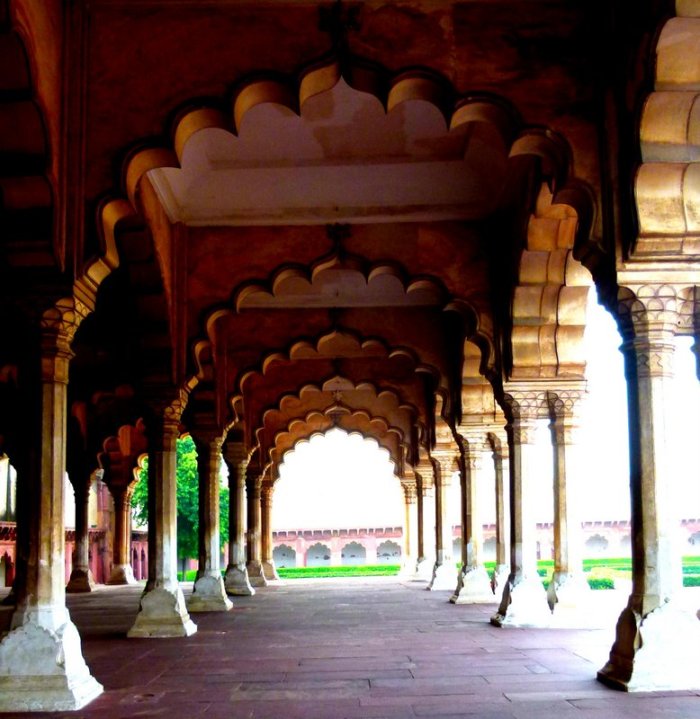
 It is 8.30 am when I walk out of the Diwan-e-Aam, the last building to see in the guided walk. I sit down on the steps just to have one last look and also think about the many thoughts that are popping in my head.
It is 8.30 am when I walk out of the Diwan-e-Aam, the last building to see in the guided walk. I sit down on the steps just to have one last look and also think about the many thoughts that are popping in my head.
- Where are the stories of the Mughal princesses? This came about when the guide mentioned that Roshanara and Jahanara, like many Mughal princesses never married. Why?
- Why is the Indian Army still occupying the Agra Fort? While it may have been necessary to have the Army in the Fort due to security reasons and ready infrastructure at the time of our Independence, I fail to see their need to occupy the Fort today 67 years later.
- Why was Shah Jahan obsessed with marble, which in my opinion, is a cold lifeless stone?
- Many of the palaces, especially Khas Mahal, were inlaid with precious and semi-precious stones and the roofs were gilded. All the palaces had an abundance of Persian silk carpets and Shah Jahan had a fine library. Nothing remains today. The carpets have been burned, the books destroyed and gilded roofs stripped and the precious stones gouged out. The British were the biggest culprits here. See the photograph below. The blue turquoise is out of the reach of an individual of average height. Everything below that has been gouged out.

I share some of these thoughts with my guide, Mohammad, who says that we can only guess and conjecture, but will never really know for real.
Mohammad has been a very good find and is everything that I look for in a guide — articulate, passionate about history, and able to separate legend and historical facts, and not shy to share his own opinion. I even earned a gentle reprimand from him for inadvertently touching the ‘painted tiles’ at the entrance ! One thing that really amused me about Mohammad was the way he spoke about the various Mughal emperors. If Akbar was mentioned with a lot of respect and reverence, Jahangir got a neutral, matter-of-fact mention. Shah Jahan was spoken about with a mix of exasperation and pity. As for Aurangzeb, Mohammad’s voice was carefully schooled to be neutral, but his flared nostrils and clipped voice gave away his deep loathing for him. 😀
As I make my way towards the exit, I see other tourists beginning to trickle in. By the time I exit they are arriving in busloads and carloads and I’m glad to be leaving. At that point, I can’t help thinking how different this second trip to the Agra Fort has turned out to be. I am really glad that this second chance to visit it came around and that I was able to visit it in the leisurely and quiet way that I prefer and like.
Mission, or rather visit, accomplished. 🙂
Read more about other places to visit in Agra:

Agra fort is much more closer to my heart than Taj. I found that I liked this one monument than any other so-called world famous one’s in vicinity. Partially because of my Maharashtrian background and love for Shivaji Maharaj’s daring escape from the fort. But that’s not the only reason. Somehow, it really did like fort better than Taj. Its much more impressive and full of history than the grand marble building.
It was superb to visit it once again in your words… Can’t tell you how much I Miss being back home… Thanks Sudha
LikeLiked by 1 person
My favourite monument in Agra, if one can call it that, is Akbar’s mausoleum at Sikandra. While the Taj is marble perfection, and I love the architecture and the symmetry and all that, it just leaves me cold.
I love Forts, and Agra Fort was no exception. When I saw Shivaji’s statue near the Fort, I was reminded of his connection to the place.
From your gravatar, I realised that you are not in India. Hope you come back home soon. Happy Diwali, Shraddha 🙂
LikeLike
Enjoyed your post. I remember my first trip to Agra Fort. It was few months after movie Pardesh was released where Shah Rukh sings “Do Dil” in the fort. The good thing about being a kid is that you can shamelessly sing that song aloud in the same place and don’t give a damn to what people may think. 😛
LikeLiked by 2 people
I have to confess my ignorance here. I haven’t seen Pardes from start to finish and only in bits and pieces. I did’nt realise that the “Do Dil mil rahe hain” was shot there. After reading your comment I checked the song out on You Tube. Avinash, the song has been shot at Fatehpur Sikri, not the Agra Fort.
Regardless, it’s wonderful to be a child and free from all inhibitions. 😀
LikeLike
lol.. I watched the video again and realized that its Fatehpur Sikri. So indeed, childhood is blissful (=ignorance ) 😛
LikeLike
selective and amazing pics with detailed post
LikeLiked by 1 person
Thank you, Yogi. Glad you liked the post. 🙂
LikeLike
Loved this post too 🙂 You were lucky to have the fort to yourself 😀 Bful pictures too, Sudha.. I actually think you should come to Delhi. Maybe we could visit the Red Fort? 😀
LikeLiked by 2 people
I had the Fort to myself thanks to the time I visited it. 🙂 An couple of hours later or at any other time, I would have been sharing it with others 🙂
Delhi has been on my radar for a long time. Somehow, I’ve just not been able to spend more than a day or two there. The last time I was in Delhi, I managed to visit Humanyun’s tomb and Lodi Gardens in between meetings. 🙂
That reminds me: I still have to write about them.
LikeLike
Lovely read 🙂 I have been to Sikri , the fort is still on my wish list. Your pictures tempt me. I have a thing for symmetry , arcs and minarets 🙂
I loved the Taj morning Haze picture 🙂 Beautiful!
LikeLiked by 1 person
Thanks, Quirkywanderer.
Fatehpur Sikri is so beautiful that it set my imagination on fire – music, dance, palace intriguw and what not. The hours that I spent there about 3 years back was fantastic.
I love architecture and have a weakness for Islamic architecture. There concept of symmetry and geometry is unparalleled..
LikeLiked by 1 person
Anguri Bagh – I liked the image. Good click.
View of Taj Mahal from Agra fort is good to watch.
If I am correct they provide headphones to listen history.
LikeLiked by 1 person
Thanks, Tushar.
There is an audio guide at the Agra Fort. However, that office opens only at 10 am, while I was there at 6.30 in the morning.
LikeLike
Reading your post after a long time. For some reason none of the photographs are visible on the screen, although the captions are very much present. As I have seen your pictures before, I do have a fair idea of what they look like. As I had seen the Agra Fort a lot many years ago, my memories are blurred. Your narration, however, has managed to refresh my memories beautifully. I too wonder why the princesses did not marry…..
LikeLiked by 1 person
Blame the non-appearance of photos on your office system. 😉
Glad you liked the post and also that it brought back some good memories, Neena.
LikeLike
Lovely guide and immersive pics.. Never been to Agra. Now, I want to… 🙂
LikeLiked by 1 person
Welcome here, Andy and thank you so much for stopping by and commenting. You must visit Agra – there is so much to see and experience there. I have been there twice, but still have much more left to see. Happy travels 🙂
LikeLike